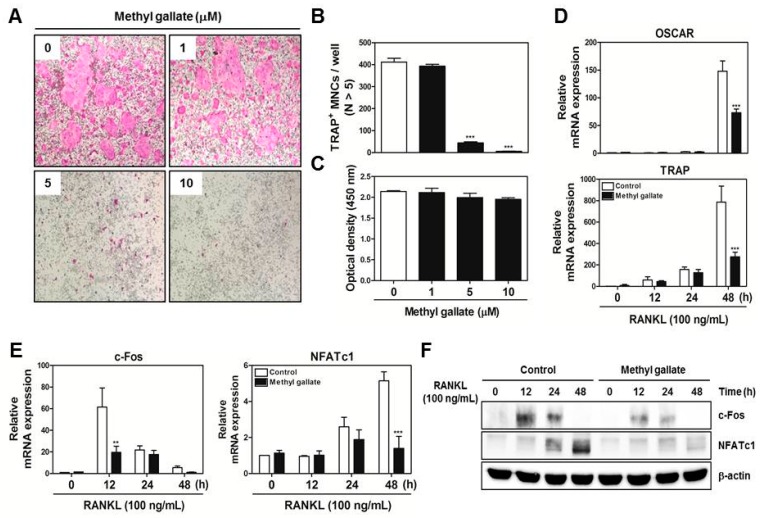Figure 1.
Methyl gallate inhibits receptor activator of nuclear factor κB ligand (RANKL)-induced osteoclastic differentiation through downregulation of c-Fos and NFATc1. (A) bone marrow macrophages (BMM)s were cultured with M-CSF (30 ng/mL) and RANKL (100 ng/mL) in the presence or absence of the indicated concentrations of methyl gallate. The cells were fixed, permeabilized, and stained with a tartrate resistant acid phosphatase (TRAP) solution. TRAP-positive multinucleated cells (MNCs) were photographed under a light microscope at the indicated magnification (10×); (B) The number of TRAP-positive MNCs (nuclei >5) was determined in these cultures. *** p < 0.001 vs. DMSO-treated control group; (C) BMMs were seeded into 96-well plates and cultured for 3 days in the presence of M-CSF (30 ng/mL) with the indicated concentrations of methyl gallate. After that, cell viability was analyzed by an tetrazolium salt sodium 3′-{1-[(phenylamino)-carbonyl]-3,4-tetrazolium}-bis (4-methoxy-6-nitro)benzene-sulfonic acid hydrate (XTT) assay; (D) BMMs were preincubated with or without methyl gallate (10 µM) for 1 h in the presence of M-CSF (30 ng/mL) and then stimulated with RANKL (100 ng/mL) for the indicated periods. The mRNA expression levels of osteoclast-associated receptor (OSCAR) and TRAP were analyzed by quantitative real-time RT-PCR. *** p < 0.001 vs. the control group at the corresponding time point; (E) The mRNA expression levels of c-Fos and NFATc1 were analyzed by quantitative real-time RT-PCR. ** p < 0.01; *** p < 0.001 vs. control group at the corresponding time point; (F) BMMs were preincubated with or without methyl gallate (10 µM) for 1 h in the presence of M-CSF (30 ng/mL) before RANKL (100 ng/mL) stimulation at the indicated time points. Whole-cell lysates were analyzed by Western blotting with the indicated antibodies. β-Actin served as internal control.

